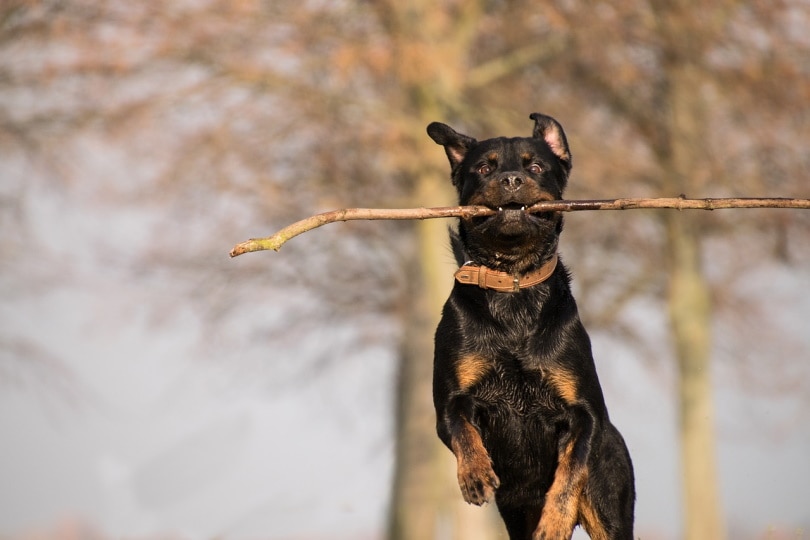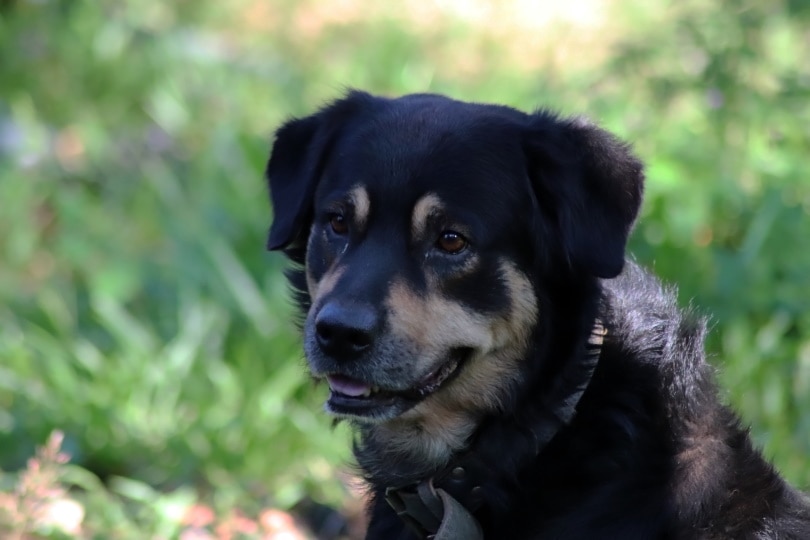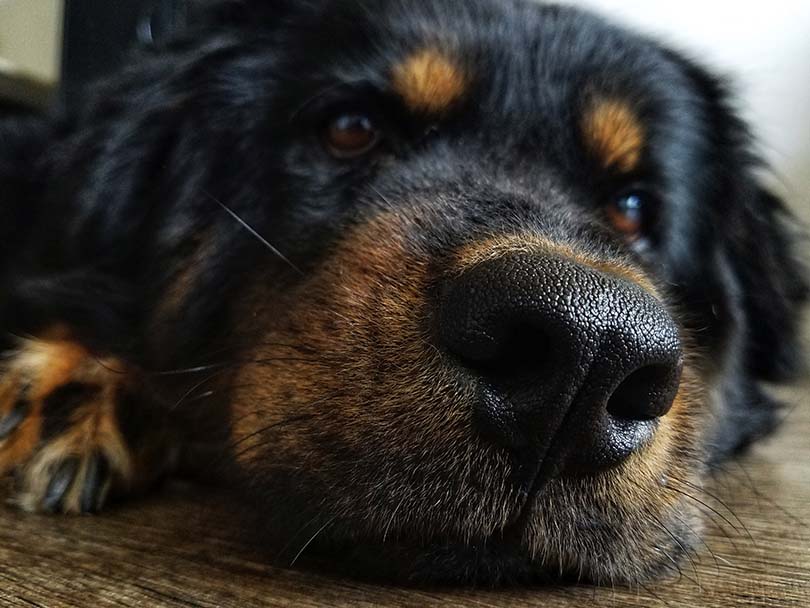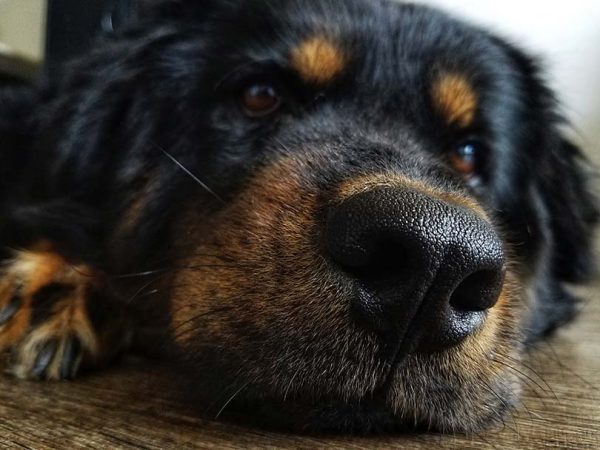Click Below to Skip Ahead
While Rottweilers have a bad reputation in some circles, the truth is that when you take a look at the breed, that reputation is entirely unjustified. These are loyal, loving, obedient, and extremely intelligent dogs. They do have a protective streak, but when you train them right, they’re a joy to have around.
Breed Overview
Height:
24–28 inches
Weight:
100–135 pounds
Lifespan:
8–12 years
Colors:
Black and brown
Suitable for:
Families, those with a fenced-in yard, experienced pet owners, and single pet households
Temperament:
Protective, gentle, loving, sweet, alert, confident, and obedient
Just keep in mind that they can be fiercely independent, and there are more than a few pet owners who respond to the whims of their Long-Haired Rottweiler instead of the other way around.
But what else do you need to know about the Long-Haired Rottweiler, and is one right for your home? We’ll break down everything about the breed here.

Long-Haired Rottweiler Puppies
Like most purebreds, the cost of a Long-Haired Rottweiler is far from cheap. They’re far more expensive than a regular purebred Rottweiler, and it’s not all that surprising, considering how much rarer they are. Tracking down a Long-Haired Rottweiler breeder is typically a much more challenging task, and they can charge a premium for their puppies. When looking for dog breeders, remember to always physically look at your puppy and check out the breeder’s facilities in person before making any payment.
Long-Hared Rottweilers might be hard to find in a dog shelter, but you can always ask and you might get surprised by finding many adorable dogs that are waiting to start a new life.
Long-Haired Rottweilers tend to be loving and obedient dogs. They’re great dogs for training but will need an experienced dog owner to handle them carefully.
Temperament & Intelligence of the Long-Haired Rottweiler
Long-Haired Rottweilers and the more standard Short-Haired Rottweiler have identical temperaments and intelligence levels. The Long-Haired Rottweiler is extremely intelligent, loyal, and obedient, but you need to train them with a steady hand and tons of consistency to get the behavioral traits that you want from them.
They’re not for the faint of heart, but if you’re confident in your abilities, a Long-Haired Rottweiler can make a great addition to your home.
Are These Dogs Good for Families? 👪
While Long-Haired Rottweilers might have a bad name in many circles, the truth is that they’re great family dogs. For starters, they’re extremely loyal, obedient, and protective. They’re also extremely careful around smaller family members, so you don’t need to worry about them accidentally falling onto the smaller kids.
Moreover, they’re large enough that a small child accidentally falling on them won’t hurt them either. Just remember that while a Long-Haired Rottweiler is an outstanding family dog, like with all dogs, you need to supervise interactions between them and smaller children.
Also, be careful when having friends over. Long-Haired Rottweilers are typically extremely friendly, but if they misunderstand a situation where children are playing, their protective instincts might kick in.

Does This Breed Get Along With Other Pets? 🐶 😽
There’s no reason that your Long-Haired Rottweiler can’t handle other pets in the home, but socializing them early and often is critical. They are large, powerful dogs, so you don’t want to find out the hard way that they can’t deal with other pets being around.
If you are thinking about socializing an older Long-Haired Rottweiler with another pet, keep them on a leash where you can control them. This way, if your Long-Haired Rottweiler starts to act out, you can restrain them as needed.

Things to Know When Owning a Long-Haired Rottweiler
While owning a Long-Haired Rottweiler isn’t drastically different than owning any other dog variety out there, there are a few things that you should be aware of before you bring one home. We highlighted a few of their basic care requirements for you here.
Food & Diet Requirements 🦴
As a large dog, your Long-Haired Rottweiler will eat a bit more than most other dog breeds. On average, you can expect your pup to eat about 6 cups of high-quality dry kibble each day.
To give them the nutrition that they need, you can expect to spend between $75 and $125 a month on dog food. Of course, you can also supplement their diet with high-quality treats, but don’t overdo it.
Exercise 🐕
A Long-Haired Rottweiler is a large and high-energy breed. Therefore, you need to give them at least 2 hours of activity a day. This can include going on walks, playing fetch, or doing other forms of physical exercise and entertainment.
These higher exercise requirements are why we recommend having a fenced-in yard if you own a Long-Haired Rottweiler, but a fenced-in yard doesn’t replace walks. You still need to take them out for about 1 hour each day and actively play with them in the yard instead of just hoping that they’ll run around.

Training 🎾
Rottweilers are extremely intelligent dogs, and when you pair this with their obedience streak, you can train them to do just about anything. However, if you’re intimated by them or display any other forms of hesitation, they can start to take the lead.
If this happens, they’ll view themselves as the pack leader, and that can make it extremely frustrating to try to train or restrain them. Start training your Long-Haired Rottweiler early, keep the training sessions short, and stay consistent.
If you do this and display a steady hand throughout the training process, your Long-Haired Rottweiler will be doing exactly what you say, when you say it, in no time!
Grooming ✂️
While a Long-Haired Rottweiler might be a cute dog because of their long fur, it also means more grooming. Long-Haired Rottweilers will shed, though not as badly as some other breeds.
You need to brush them out a few times a week to keep their fur from matting and their shedding under control. From there, brush their teeth a few times a week to keep up with their oral hygiene.
While your Long-Haired Rottweiler might not like it at first, keeping up with their oral hygiene can save you thousands of dollars in dental visits down the road.
Finally, while exercise should keep your pup’s nails in check, it’s still a good idea to keep an eye on them to ensure that they’re not getting longer than they should.
Health and Conditions 🏥
While Rottweilers aren’t overly prone to too many health problems, there are a few that you should be aware of. The most common problem to affect Rottweilers is hip dysplasia, but it’s not the only one that you need to keep an eye out for.
If you start to notice any of the following conditions, you should take your Long-Haired Rottweiler to a vet as soon as possible. Keep in mind that the best way to keep your Rottweiler healthy is to put them on a high-quality dog food and keep up with all their exercise requirements.
- Cataracts
- Obesity
- Allergies
- Cardiomyopathy
- Subaortic stenosis
- Progressive retinal atrophy
- Hip dysplasia
Male vs Female
While there aren’t that many differences between male and female Long-Haired Rottweilers, there are at least two that you should be aware of. First, male Long-Haired Rottweilers tend to be larger compared to their female counterparts.
This is where the wide size range comes from. Most female Long-Haired Rottweilers weigh close to 100 pounds, and some might even weigh less! However, typical males will weigh closer to 120 or even 130 pounds.
But while their size difference might be the most notable physical attribute difference, you’ll likely notice a difference in their temperament too. Males tend to be in your face and need a bit more attention, and they are also prone to territorial tendencies.
Females still need attention, but they want you to come and give it to them. They are typically a little more independent and aloof, and males are a bit needier. Of course, this does come down to your dog’s individual personality too, but there are links between common behaviors and their sexes.
The 3 Little-Known Facts About the Long-Haired Rottweiler
1. They Have the Same Temperament as Short-Haired Rottweilers
While they might be far rarer and look different than Short-Haired Rottweilers, they have an identical temperament. They share the same genetic lineage, so the only difference is the trait that controls the length of their hair!
2. They Originally Came From Rome
While many people link Rottweilers to Germany, the Romans were actually the ones that introduced Rottweilers to Germany in the first place. The Romans used them as farm dogs due to their muscular build and fierce obedience.
3. They Are Quite Trainable
While Rottweilers might have a strong-willed personality, if you’re an experienced handler, there’s nothing that you can’t train them to do. They’re extremely intelligent and obedient, and their independent streak means you can trust them to complete the task even after you leave.


Conclusion
If you’re looking for a great family dog and are confident in your ability to train them, a Long-Haired Rottweiler might be exactly what you’ve been looking for. They’re rarer and more expensive than a typical Short-Haired Rottweiler, but when you first lay eyes on them, you’ll see why they’re so popular.
Just ensure that you have everything that you need to take care of them before bringing home a puppy because they won’t stay that small for long!
Featured Image Credit: Kim Hefner, Shutterstock









